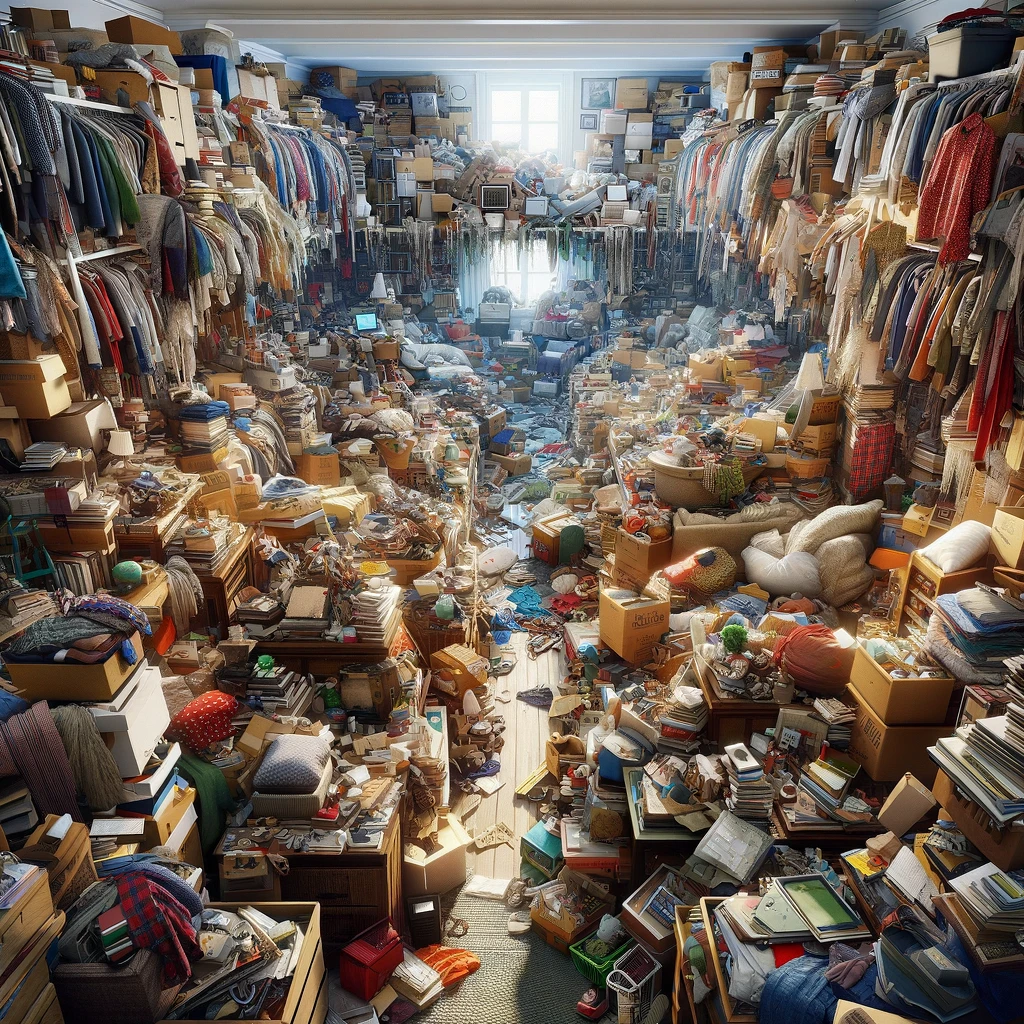Why do hoarders keep buying stuff even when their spaces are overflowing? At the crux of hoarding behavior is a complex interplay of psychological factors, emotional attachments, and sometimes, genetic predispositions. People with hoarding tendencies are often battling a compulsive urge to buy, aggravated by an emotional response to possessions, which they may see as extensions of their identity or as emotional comforts. This article delves into the multifaceted reasons that underlie this compulsive buying and hoarding, offering insights into the hardships these individuals face and the treatments available to help them.
Key Takeaways
-
Hoarding and compulsive buying disorders often co-occur and are associated with anxiety disorders and OCD, creating a complex challenge for treatment due to the cycle of acquisition and difficulty in discarding possessions.
-
Psychological factors such as impulse control disorders and OCD symptoms significantly contribute to hoarding behaviors, with high impulsivity, novelty seeking, and difficulty discarding possessions due to overvalued beliefs.
-
Treatment for hoarding and compulsive buying includes Cognitive Behavioral Therapy (CBT), support groups, and, in some cases, medications such as SSRIs, offering various strategies for managing and overcoming these disorders.
The Link Between Hoarding and Compulsive Buying

Hoarding and compulsive buying are intimately linked. The urge to acquire more items is hard for hoarders to resist; in fact, 61% also meet the criteria for compulsive buying. This buying compulsion feeds their hoarding tendencies, leading to an overabundance of possessions. Consequently, those grappling with both disorders frequently experience intensified buying symptoms, decision-making struggles, and more extreme hoarding behaviors.
These disorders don’t exist in a vacuum; they form a complex network of mental health problems, commonly co-existing with anxiety disorders and obsessive-compulsive disorder (OCD). The intricate relationship between hoarding, compulsive buying, and other mental disorders poses a multifaceted challenge for their treatment and management.
Compulsive Buying Disorder
Compulsive Buying Disorder, also known as shopping addiction, is characterized by an excessive preoccupation with shopping, leading to detrimental outcomes. This disorder affects an estimated 5.8% of Americans, and it’s not just about a love for shopping. It’s about a fixation on shopping, tension or anxiety before making a purchase, and a feeling of relief after buying something. This disorder is often linked to substantial psychiatric comorbidity, such as:
-
mood disorders
-
anxiety disorders
-
substance use disorders
-
other impulse control disorders
The ramifications of Compulsive Buying Disorder extend past monetary consequences, potentially causing severe mental health issues like depression and anxiety. Imagine the constant stress and anxiety of feeling an uncontrollable urge to shop, followed by the guilt and regret after making unnecessary purchases. It’s a vicious cycle that can be incredibly hard to break.
The Role of Negative Emotions
Apart from compulsive behaviors and anxiety disorders, the influence of negative emotions is another pivotal factor to consider. Compulsive buying is often associated with a range of negative emotions, including:
-
anger
-
loneliness
-
frustration
-
guilt
-
a sense of emotional void
Anxiety, in particular, plays a significant role in compulsive buying. It increases the likelihood of impulsive purchases, often as a response to negative emotions. This can lead to a vicious cycle where the individual buys to alleviate negative feelings, only to experience guilt and stress after the purchase, leading to more shopping to cope with these feelings. This cycle can exacerbate hoarding problems, as the excessive acquisition of items contributes to the buildup of possessions.
Psychological Factors Behind Hoarding Behavior
To comprehend hoarding behavior, one must venture into the realm of psychology. Hoarding is often associated with impulse control disorders and obsessive-compulsive symptoms,. Individuals who hoard often find it difficult to resist the urge to acquire items, and this impulse control disorder makes it even more challenging for them to refrain from buying items.
On the other hand, hoarding behaviors are also linked to obsessive-compulsive disorder (OCD). Many individuals who hoard exhibit difficulty discarding possessions due to a fear of needing to save them – a behavior often linked to OCD. Hoarding can be more than just a problem with clutter; it’s a complex mental health issue that often requires professional intervention and can pose a health risk.
Impulse Control Disorders
Impulse Control Disorders (ICDs) encompass a variety of conditions that hinder an individual’s capacity to control their actions or reactions. These disorders are characterized by a lack of self-control, impatience, and often, compulsive thought patterns. Compulsive hoarding and compulsive buying are interconnected within the compulsive-impulsive spectrum. In fact, many individuals struggling with hoarding also exhibit compulsive buying tendencies.
In the realm of compulsive buying, high impulsivity scores, novelty seeking, and compulsivity are often observed. When it comes to hoarding, lower levels of self-control are frequently noted. Acquisition behaviors in hoarding exhibit similarities with impulse control disorders, suggesting a potential connection.
In essence, Compulsive Buying Disorder is an example of a specific impulse control disorder that is closely linked with compulsive buying and hoarding behaviors.
Obsessive-Compulsive Symptoms
Examining hoarding behavior from the perspective of obsessive-compulsive disorder (OCD) reveals an even more intricate picture. Hoarding is often considered a subtype of OCD, and many of the symptoms overlap,. Many individuals who hoard exhibit difficulty discarding possessions due to a fear of needing to save them, a behavior often linked to OCD.
Hoarding behaviors can be a manifestation of underlying OCD symptoms. For instance, individuals who hoard often experience:
-
an earlier onset of OCD
-
higher prevalence of comorbid tic disorders and social phobia
-
challenges in discarding possessions due to overvalued beliefs about their significance or utility
This intricate link between OCD and hoarding makes it challenging to treat and manage these conditions.
The Impact of Family History and Genetics
A thorough understanding of hoarding behavior also necessitates an examination of family history and genetic influences. Studies suggest a strong influence of family history on hoarding behavior, with older adults with hoarding disorder frequently having a family background with similar behaviors. Family dynamics and behavior can influence hoarding tendencies in individuals, with high rates of family accommodation among families of hoarders.
Some key factors to consider include:
-
Family history of hoarding behavior
-
Genetic influences on hoarding tendencies
-
Family dynamics and behavior that may contribute to hoarding tendencies
-
High rates of family accommodation among families of hoarders
By examining these factors, we can gain a better understanding of the complex nature of hoarding behavior.
The role of genetics in hoarding can’t be overlooked. Twin studies have revealed that as much as 50% of the variation in hoarding behaviors could be genetically associated. A particular region on chromosome 14 has been linked to compulsive hoarding in families affected by OCD, further emphasizing the genetic basis of the disorder.
Family History
Family history significantly influences the onset of hoarding behavior. Having a family member with hoarding disorder increases the likelihood of an individual developing the same disorder. The presence of hoarding behavior in one’s upbringing environment may lead to the adoption of similar habits and behaviors.
Parental attitudes, especially those involving rejection or exhibiting hoarding behaviors, can have a significant impact on a child’s likelihood of developing hoarding behaviors. Moreover, family environments characterized by elevated levels of frustration, hostility, and rejecting attitudes can intensify the severity of hoarding symptoms and the individual’s perceived lack of insight into their behaviors.
Genetic Factors
While family history offers a backdrop for comprehending hoarding behavior, genetics lays the biological groundwork. Genetic factors are believed to play a significant role in the development of hoarding disorder. Twin studies suggest that as much as 50% of the variation in hoarding behaviors could be genetically associated,.
A region on chromosome 14 has been associated with compulsive hoarding behavior in families with OCD, suggesting a genetic link to the disorder. Although more research is needed to pinpoint the specific genes involved, these findings underscore the importance of genetic factors in understanding hoarding behavior.
Coping Mechanisms and Emotional Attachment
At first glance, hoarding may appear as an amplified form of materialism. Yet, it’s frequently less about the possessions’ worth and more about the emotional bond with them. Hoarders often form profound emotional and sentimental connections to their possessions, which they perceive as an extension of their own identity.
Furthermore, for many individuals with hoarding disorder, shopping acts as a coping mechanism. It offers temporary relief from negative emotions and anxiety, helping them manage their distress. Unfortunately, these coping mechanisms can lead to a vicious cycle of shopping, hoarding, and emotional distress.
Emotional Attachment to Possessions
Emotional attachment to possessions can drive hoarding behavior. This attachment can be driven by:
-
sentimental value
-
personal memories
-
self-identity expression
-
comfort
-
social relationships
The emotional connection to possessions is often profound, and hoarders frequently turn to these items for emotional solace.
This emotional attachment can make it extremely hard for hoarders to part with their possessions. They often experience significant distress when attempting to discard items, perceiving these possessions as integral to their identity. This emotional connection often corresponds with the extent of their hoarding behavior.
Shopping as a Coping Mechanism

Shopping can serve as a coping mechanism for individuals with hoarding disorder. It provides temporary relief from emotional distress and operates as a form of retail therapy or emotional spending. However, the immediate relief provided by shopping can lead to long-term emotional effects, including:
-
feelings of regret
-
remorse
-
shame
-
guilt
-
anxiety
-
depression
-
reduced self-esteem
The relationship between stress levels and shopping behavior, particularly during a stressful life event, has been well-documented. Stress can influence the amount of time and money individuals allocate to shopping, particularly online, and prompt them to either engage in impulsive purchasing or, conversely, save money and make deliberate purchases. In essence, compulsive shopping can provide stress relief by enabling individuals to fill a void and participate in emotionally fulfilling activities that help alleviate stress and anxiety cravings.
Treatment Options for Hoarding and Compulsive Buying
Despite the substantial challenges posed by hoarding and compulsive buying disorders, a range of treatment options are available. The primary therapeutic approach for addressing these disorders is Cognitive Behavioral Therapy (CBT). CBT focuses on:
-
Recognizing and questioning the cognitive patterns and beliefs that underlie these behaviors
-
Fostering the development of effective coping mechanisms
-
Developing problem-solving abilities
By utilizing CBT, individuals can work towards overcoming hoarding and compulsive buying behaviors.
In addition to CBT, support groups also play a crucial role in managing these disorders. They offer a secure and accepting environment for individuals to share their experiences, obtain support and motivation, and gain insights from others facing similar difficulties.
For some, medications such as selective serotonin reuptake inhibitors (SSRIs) can also be recommended off-label to assist in symptom management, following guidelines from the Diagnostic and Statistical Manual.
Cognitive Behavioral Therapy (CBT)
Cognitive Behavioral Therapy (CBT) is a widely used treatment approach for hoarding disorder. CBT centers on the impact of thoughts, beliefs, and attitudes on emotions and behavior, and imparts coping mechanisms for managing challenging circumstances. The therapy encompasses a skills-based therapeutic approach aimed at enhancing the ability of individuals to manage thoughts and behaviors associated with hoarding effectively.
The treatment usually involves weekly sessions conducted over several months. It has significantly improved hoarding symptoms and relief from Hoarding Disorder (HD) symptoms. Additionally, Group Cognitive Behavioral Therapy (GCBT) has effectively addressed hoarding disorder.
Support Groups
Support groups offer a secure and supportive platform for individuals grappling with hoarding and compulsive buying disorders. They offer a platform for individuals to exchange their experiences, obtain support and motivation, and gain insights from others facing similar difficulties. Support groups play a vital role in providing anonymous encouragement, sharing coping tips, offering insights into reasons behind excessive shopping, and helping individuals recognize when professional help is needed.
Resources for support groups can be found through various channels, including the International OCD Foundation website and Hoarders.com. These groups can complement existing treatments or serve as an alternative treatment approach. Specialized self-help groups are also available to assist compulsive shoppers in recognizing and steering clear of triggers, as well as providing support for family members of hoarders.
Summary
In conclusion, hoarding and compulsive buying are complex disorders intertwined with a myriad of psychological, emotional, and social factors. From impulse control disorders and obsessive-compulsive symptoms to family history, genetics, and emotional attachments, these conditions are far more than just a problem with clutter. Understanding the intricate web of factors at play is the first step in addressing these disorders effectively. The journey towards recovery may not be easy, but with the right help and support, it is certainly possible.
Frequently Asked Questions
What mental illness do most hoarders have?
Most hoarders have mental health conditions such as obsessive-compulsive personality disorder (OCPD), obsessive-compulsive disorder (OCD), and attention deficit/hyperactivity disorder (ADHD). This can greatly impact their ability to declutter and organize their living space.
Why can’t hoarders get rid of stuff?
Hoarders can’t get rid of stuff because of an intense resistance to discarding belongings, known as disposophobia, which causes extreme anxiety. They often have strong emotional attachments to their possessions, finding them beautiful, useful, or sentimental.
Is compulsive buying related to hoarding?
Compulsive buying is indeed related to hoarding, as nearly all hoarders suffer from compulsive buying, while not all compulsive buyers are hoarders. Hoarding and compulsive buying often go hand in hand, with individuals identified as compulsive buyers showing higher levels of hoarding behavior.
What is the root cause of hoarding?
The root cause of hoarding can be attributed to a combination of factors, including altered brain connections, genetics, stress, OCD, environmental factors, altered levels of serotonin, deficits in decision making, inattentiveness, lack of inhibition, and stressful life events, such as the death of a loved one. These factors contribute to the development of hoarding disorder.
How does family history influence hoarding behavior?
Having a family member with hoarding disorder significantly increases the likelihood of an individual developing the same disorder. This influence is prominent and can impact behavior.
[/et_pb_text][/et_pb_column][/et_pb_row][/et_pb_section]

